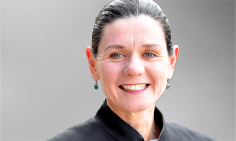AMONG the many splendid and occasionally disappointing sights encountered during a recent road trip across the country, there is one in particular that stands out.
We found it just a short drive from the small, well tended town of Sandstone in the mid west of WA.
You follow a smooth red-dirt road popular with gold prospectors, turn a corner, and there it is: what some might describe as a “weathered rock arch”.
For us, it was more like a magical window, framing the view over an ancient landscape. The red rock stands in stunning contrast to a blanket of grey and green scrub stretching to the distant horizon.
A nearby sign declares this wondrous work of nature to be “London Bridge”.
[[{“type”:”media”,”view_mode”:”media_large”,”fid”:”45894″,”attributes”:{“alt”:””,”class”:”media-image”,”height”:”150″,”typeof”:”foaf:Image”,”width”:”180″}}]]
The dissonance between the name and the place is striking. It is absurd. And it also seems insulting to the area’s traditional owners.
To be worthy of its name, a road trip must, of course, have some greater purpose than simply the physical journey. In our case, one of the quests of our 7370 km drive was to learn about the diverse histories, cultures and stories of the Aboriginal people in the places that we visited.
As we drove through country towns in WA, SA, Victoria and NSW, we looked at tourist signage and information leaflets. We searched local history displays and books. So often, it was as if the Aboriginal history was invisible.
Fairly typical was the sign at Rocky Pool, a picturesque permanent waterhole on the Gascoyne River between Carnarvon and Gascoyne Junction, which declared the area had “become a popular picnic spot in the last 50 years”. I’m pretty sure the traditional custodians were feasting there for many thousands of years before that.
The omissions were also in the interpretation. Much tourist information extols the feats of early European settlers in opening up the land for pastoral or mining development, and does not acknowledge what this meant for the Aboriginal peoples, their waterholes, food supply and way of life.
I kept trying to imagine what it must be like to live in or to visit places where the public signage and information makes it seem like you, your history, your culture and your language don’t exist. For white Australians, this requires a considerable feat of imagination.
There were some impressive exceptions. The small town of Menzies, north of Kalgoorlie, has a fabulous street art installation where the Wongi people share some of their history of survival and resilience. “Ngalya bitha, nooda ngali goolila ngali-paku milbindi”, they say — “Come along, you and I — listen to our stories”.
In Carnarvon, the Gwoonwardu Mia (or Gascoyne Aboriginal Heritage and Cultural Centre) is worth travelling any distance to see and experience.
[[{“type”:”media”,”view_mode”:”media_large”,”fid”:”45895″,”attributes”:{“alt”:””,”class”:”media-image”,”height”:”150″,”typeof”:”foaf:Image”,”width”:”180″}}]]
It shares some powerful, haunting stories and embodies many of the approaches outlined by Maori researcher Professor Linda Tuhiwai Smith in her revolutionary book, Decolonizing methodologies: research and Indigenous peoples, whose second edition was published last year.
She makes a strong case that Western research has contributed to the colonisation of Indigenous peoples, and stresses the importance of using Indigenous naming, reclaiming Indigenous history and knowledge, and celebrating survival.
These approaches are evident in the award-winning Carnarvon centre, and also offer some lessons for the public health field more broadly. So much of the focus on place as a determinant of health is very narrowly focused — whether the “built environment” promotes physical activity, for example.
One notable exception is research by Jonathan Kingsley and colleagues at Deakin University, who have been exploring the links between Aboriginal wellbeing and connection to Country. In a recent paper in the International Journal of Environmental Research and Public Health, they describe many ways that connection with Country helps wellbeing.
All of which is a reminder of how mainstream Australia contributes — often without realising it — to the health problems of Aboriginal and Torres Strait Islander people.
When Indigenous history, culture and knowledge are not acknowledged in our shared public places, it has a powerful impact. Non-Indigenous Australians also miss an opportunity for learning and enrichment.
And so, our road trip left me with far more questions than answers — as well as a sense of longing for that beautiful, red-dirt country.
Melissa Sweet is a public health journalist, an adjunct senior lecturer at the Sydney School of Public Health at the University of Sydney and is currently undertaking a PhD in Indigenous health and journalism.

 more_vert
more_vert